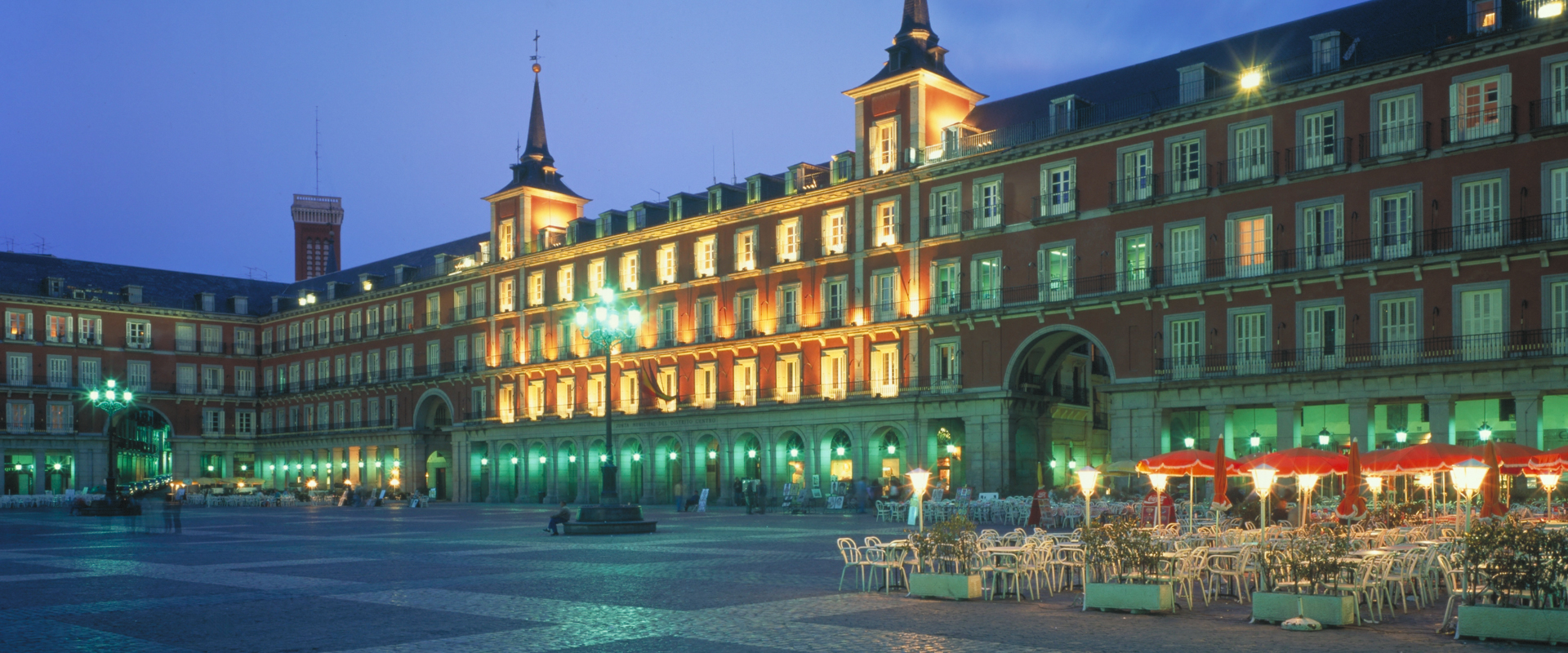Madrid. Where Spain Begins...
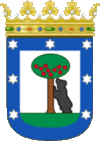 Madrid is as good as a city can be. As soon as you enter the city you immediately get a sense of her grandeur. There’s nothing Madrilenes love more than extolling the virtues of their beloved city. But then, as you will discover, they’ve got a lot to be proud of.
Madrid is as good as a city can be. As soon as you enter the city you immediately get a sense of her grandeur. There’s nothing Madrilenes love more than extolling the virtues of their beloved city. But then, as you will discover, they’ve got a lot to be proud of.
As you drive along the wide Paseo de la Castellana Avenue or pass by the Puerta de Alcala, a triumphal gate built by King Charles I, you’ll find yourself in a city like no other. Replete with the regal splendor of a long, lost bygone era. Buildings are trimmed in gold with Greek Gods basking on their roofs. In the former Regal Salamanca district, you will admire the unmistakable Bank of Spain building, the Spanish Post Office regal building, and the fountain of Cibeles and Neptuno, next to “Paseo del Arte“, so called for its unique museums, palaces and gardens.
The Madrid area has been settled since the Lower Paleolithic age, but it was not until 1561 that King Philip II made it the capital of his mighty empire. The historic quarter, also known as “Madrid de las Austrias” (referring to the Hapsburg Empire) is a living example of the city’s 16th and 17th century heyday, as is its impressive Plaza Mayor (square), which was opened in 1620. It remains one of Spain’s most popular and typical spots.
Near La Plaza Mayor is the so-called “Aristocratic Center” of Madrid, home to the stunning Royal Palace, a 17th century monument that combines Baroque and Classical styles. Next to the palace you will find the Plaza de Oriente Square, the Opera Houseand the Almudena Cathedral, consecrated in 1993 by Pope John Paul II. This ensemble of monuments also leads to La Puerta del Sol, a popular square flanked by great shops and also known as kilometer zero. From here distances are measure to other cities in Spain. Close by you is the popular Gran Via Avenue also a favorite for shopping, cafes, theaters and restaurants.
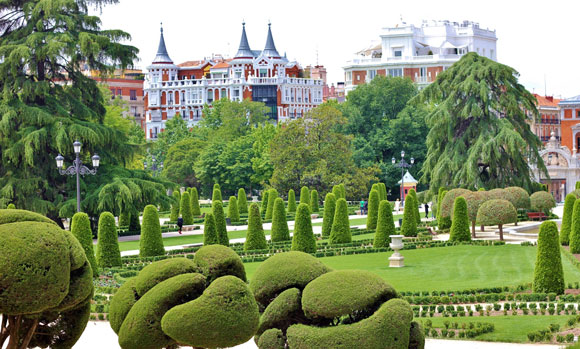
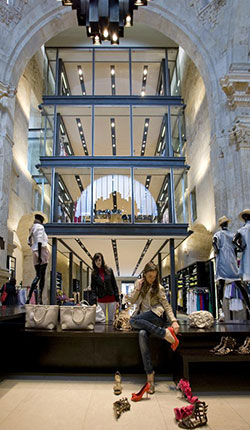 Now you can enjoy a private day of great shopping in Madrid that you will not forget. A private guide and driver will greet you take you to the best places in Madrid to shop, find great deals known to locals and make sure you benefit from the visitor’s tax-free prices.
Now you can enjoy a private day of great shopping in Madrid that you will not forget. A private guide and driver will greet you take you to the best places in Madrid to shop, find great deals known to locals and make sure you benefit from the visitor’s tax-free prices.
They will take you to the elegant Salamanca District, where you can find the latest fashions, accessories and perfumes in selected stores and boutiques of designers such as Adolfo Dominguez, Purification Garcia or the Loewe brand to name a few.
Your guide will also accompany you to shop in some of Spain’s favorite department stores, like El Corte Ingles, full of wonderful domestic and international products, and take you to specialty gourmet and wine stores where you can find Spain’s finest Wines, Sherrys and Olive Oil at a great value.
And if you like traditional and unique ceramics, they will introduce you to stores specializing in Spain’s Lladro’s collection.
In Madrid they will help you find excellent bargains and unique items in El Rastro, Europe’s biggest Flea Market. They say you can find everything from a used pair of gloves to original antiques!
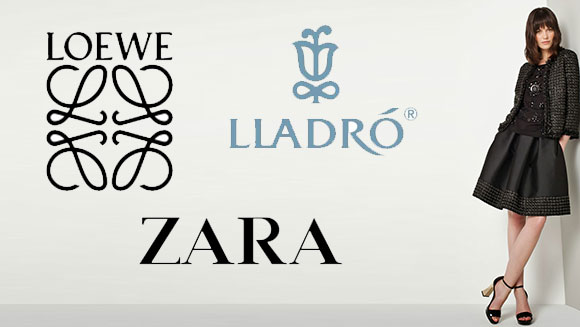
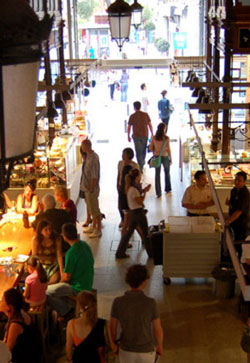 Every meal in Madrid is a culinary adventure. Whether it’s Tapas or a sit down Lunch and Dinner, Madrid offers the gourmet lover excellent restaurants, exquisite traditional gastronomy and a Madrid Fusion Cuisine, always accompanied by the best wines. There are over 3,000 restaurants to choose from. Many with Michelin stars.
Every meal in Madrid is a culinary adventure. Whether it’s Tapas or a sit down Lunch and Dinner, Madrid offers the gourmet lover excellent restaurants, exquisite traditional gastronomy and a Madrid Fusion Cuisine, always accompanied by the best wines. There are over 3,000 restaurants to choose from. Many with Michelin stars.
Start your tour of Madrid’s Gastronomy with a visit to two of the city’s great markets which reflect the diversity of Spain’s Gastronomy. First you’ll visit the popular Mercado de San Miguel Market next to Plaza Mayor, a beautiful turn of the century building. Here you will join the locals and international ‘food lovers’ savoring the incredible produce and dishes from all regions that can be found, as well as great Spanish wines. This market is also a favorite for evening Tapas.
Your next stop is the Mercado de San Anton Market in the popular neighborhood of Chueca. The Market dates back to the 19th century, and also offers an impressive variety of Spanish specialties. During your ‘foodie’ adventure don’t be surprised if you run into some of Madrid’s popular Chefs buying and tasting the freshness of the daily produce, seafood and meats. After your tour of this market you might want to enjoy ‘tapas’ and excellent wines in their rooftop bars.
Every evening all of Madrid chooses to visit their local neighborhood bars, or walk to the historic Tapas District the largest in Spain, and partake of Tapas accompanied by a glass of wine, beer or the popular Sangria. If you choose to join them, you can stop in one of the very traditional bars dating back to the 18th century or a modern bar, each with its very own special Tapas.
You may choose to relax in one of the many open cafes while sipping a glass of wine. Madrid has great open cafés in places like Plaza de Santaor Plaza Mayor which come alive every evening. You will find that most places are open past two or three in the morning!

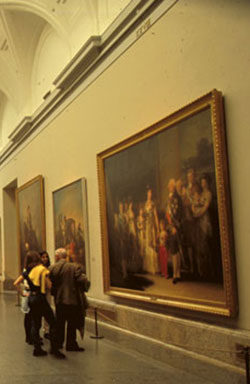 Today enjoy a comprehensive tour of the magnificent El Prado Museum, which houses the largest and finest collection of Spanish and European masters. The collection dates from the 12th century to the 19th century. The Museum is the most visited in the world. It is home to Velazquez iconic painting Las Meninas.
Today enjoy a comprehensive tour of the magnificent El Prado Museum, which houses the largest and finest collection of Spanish and European masters. The collection dates from the 12th century to the 19th century. The Museum is the most visited in the world. It is home to Velazquez iconic painting Las Meninas.
You’ll be guided on a historic and retrospective tour of the Spanish Masters, such as Zurbano, Goya and El Greco that contributed to the evolution of art in the old continent. You will also admire other important European painters such as Rubens, Titian and Bosch.
Then continue to the Reina Sofia Museum. Highlights of this magnificent museum feature mostly Spanish Masters from the 20th Century such as Pablo Picassoand Salvador Dalí. Here you will also be given and introduction a description of some of the masterpieces featured in the permanent collection such as the controversial Guernica painting by Picasso. You will also find other great Spanish featured artists such as Joan Miro, Juan Gris or the sculptor Eduardo Chillida.
You will also admire some of the works by other international artists like Georges Braque, Francis Baconor Gabriel Orozco. The museum also has over 100,000 books and a great collection of videos and information on Spain’s Spanish Civil War.
After lunch, you will visit the Thyssen Bornemizma Museumwith a magnificent collection of Flemish, Dutch, English and German Art, as well as a magnificent collection of Impressionism Art. The museum is located close to El Prado Museumon the elegant Avenue of La Castellana. The collection was started by Heinrich Baron Thyssen Bornemizma de Kaszon. You will find great works by master painters like Jan Van Eyck, Hans Holbein, Caravaggio as well as Claude Monet, Cezanne and Paul Gauguin and Copley and John Singer Sargent to name a few.
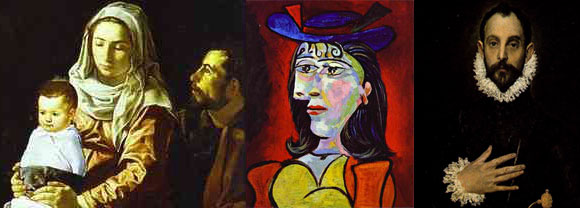
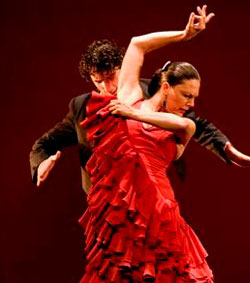 If there is one thing, however, that characterizes Madrid, is the deep, contagious passion for life, friends and family which surfaces at night. A culture all in itself.
If there is one thing, however, that characterizes Madrid, is the deep, contagious passion for life, friends and family which surfaces at night. A culture all in itself.
Every night all of Madrid steps out and gets together to enjoy “Tapas“, attend a Play, the opening of an Opera or see the latest rising Flamenco artist. You can find great authentic Flamenco “Tablaos“. Or you may want to attend the traditional Verbena de la Paloma (open-air traditional musical opera dating back to the 18th century) in the historic district of “Lavapies” while enjoying the traditional hot chocolate and “churros” that accompanies this event.
If you prefer, you can attend the popular festivals such as the San Isidro Festival which in addition to its city celebrations hosts some of the best bullfights in Spain. If you like dancing, you will find an array of night clubs with great ambiance spread all throughout the city.
The fact is when it comes to culture and nightlife no other city comes close to Madrid. A feast for the eyes, ears and heart. In Madrid the excitement doesn’t stop until “the sun also rises”.
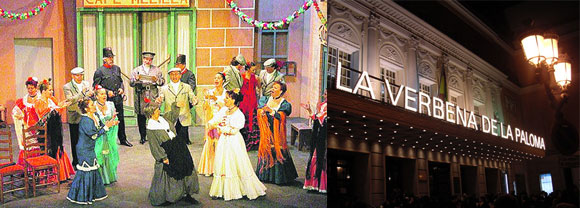
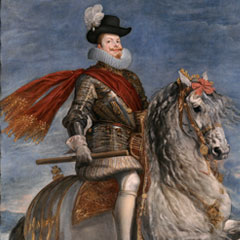 The best way to discover Madrid is by walking, the way locals do it. Enjoy a walking tour of Madrid’s historic quarter, when you follow the Route of Velazquez and the Hapsburgs and Bourbon Royalty. You’ll walk by La Puerta del Sol and the thriving Plaza Mayor.
The best way to discover Madrid is by walking, the way locals do it. Enjoy a walking tour of Madrid’s historic quarter, when you follow the Route of Velazquez and the Hapsburgs and Bourbon Royalty. You’ll walk by La Puerta del Sol and the thriving Plaza Mayor.
Continue through the many narrow streets of Old Madrid full of history and hidden Convents. You will visit Madrid’s Our Lady of Almudena Cathedral, The Basilica of Saint Francis of Assisi and Convent of the Royal Barefoot Sisters, where you will find great works by masters Rubens, Coello and Titian. Your final stop will be the magnificent Royal Palace and Florentine Gardens, which you will tour facing Madrid’s Opera House on one side and offering great panoramic views on the other.
Be sure to stroll through one of Madrid’s large magnificent parks and gardens, or the Park El Retiro once the private hunting grounds of Kings. Now it’s a favorite get-away and relaxing place for walks, rowing. Or you might want to visit La Casa de Campoor the Juan Carlos I Park, among others which make Madrid one of Europe’s greenest capitals.
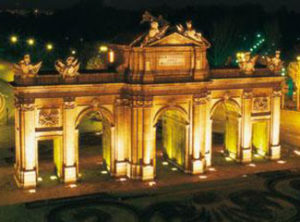
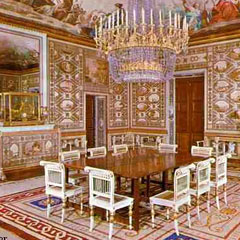
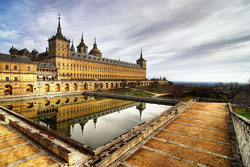 Travel to the magnificent El Escorial Monastery Palace, a historical residence in the medieval town of San Lorenzo del Escorial. The Royal Monastery of El Escorial is known as the eighth wonder of the world, and in 1984, was declared a World Heritage Site by the UNESCO.
Travel to the magnificent El Escorial Monastery Palace, a historical residence in the medieval town of San Lorenzo del Escorial. The Royal Monastery of El Escorial is known as the eighth wonder of the world, and in 1984, was declared a World Heritage Site by the UNESCO.
This work of universal dimension functions as a royal palace, museum, and school. It was founded in the 16th century by King Philip II of Spain, after his victory against the French, in the battle of San Quintin. From here he ruled both his court and the Spanish Empire. King Philip II shared his power with the ecclesiastical Roman Catholic Church who supported him in his fight against the Protestant Reformation taking root throughout Europe, in the 16th century. During his long reign he devoted himself and invested much of the incoming New World gold and riches towards this religious war.
King Philip II chose Spanish architect Juan Bautista de Toledo, to design and build the Royal Monastery. He originally worked on Rome’s St. Peters Basilica. The Monastery is host to a magnificent collection of art and frescoes, compared by many to the Vatican’s. Together King Philip II and Juan Bautista, collaborated on the design of El Escorial with the goal of making it a symbol of the Christian World. It took over 20 years to complete.
El Escorial once belonged to the Hieronymite Monks, who chronicled its progress. Since then it has been passed on to the Order of Saint Augustine. After your tour, enjoy lunch in one of the local restaurants, before returning to Madrid.
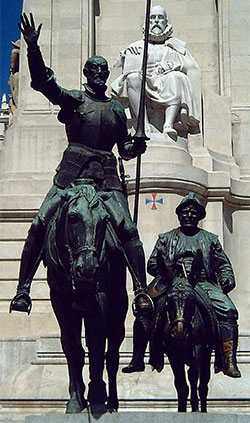 Your day starts with a tour of the magnificent Madrid’s Institute of Cervantes. The Cervantes Institute is the largest in the world and was created to promote the study and teaching of the Spanish Language and culture. The Institute is also home to an excellent Library.
Your day starts with a tour of the magnificent Madrid’s Institute of Cervantes. The Cervantes Institute is the largest in the world and was created to promote the study and teaching of the Spanish Language and culture. The Institute is also home to an excellent Library.
Next you’ll travel by train to historic Alcala de Henares, birthplace of Miguel de Cervantes Saavedraand home to one of Europe’s oldest Universities.
Here you’ll visit the Home of the celebrated Cervantes. It’s not only the birthplace of Spain’s greatest writer, but a museum containing the first edition of his masterpiece, Don Quijote de la Mancha, along with other historic dated publications. These historic surroundings also inspired Miguel de Cervantes great masterpiece back in 1605. Ironically he died a day before his contemporary, William Shakespeare, on April 22, 1616.
Right in the heart of this city is the renowned University of Alcala de Henares, one of the foremost places of learning in 16th Century Europe. One of its many famous alumni was the playwright Lope de Vega, also born in Alcala. The university was founded in 1499 by Cardinal Cisneros and made up of over 40 different colleges. You’ll also visit San Ildefonso College, one of its oldest and most famous colleges. Your tour will take you to the beautiful Cathedral of Alcala.
Then continue to the Church of Magistral de los Santos Justo y Pastor. Your tour will end by the magnificent Plaza of Cervantes. After lunch in one of the many great restaurants that abound in Alcala, you return to Madrid.
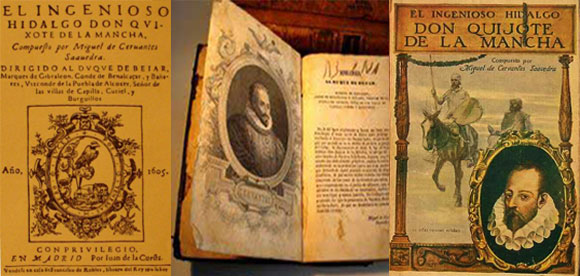
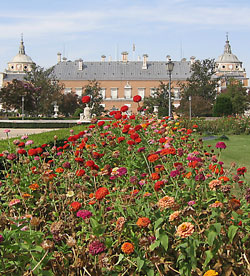
 Aranjuez – Royal Summer Residences
Aranjuez – Royal Summer Residences
Today you travel by train to beautiful Aranjuez. Your visit starts with the Royal Palaceand Gardens of Aranjuez, which originally functioned as a medieval hunting lodge. It has gone on from its modest beginning to become the summer residence of the Hapburgs and Bourbons, and a popular place for weddings. Your tour to the palace will take you through numerous Baroque rooms, including the famed Chinese Porcelain Room, the Hall of Mirrors and the Smoking Room modeled after a room in the Alhambra.
Then continue to the beautiful and stately manor La Casa del Labrador, built during in the 18th century. During your visit to the Manor and Gardens you’ll learn of the many conspiracies that took place here, plus the effect the French Napoleon occupation had on Aranjuez.
You’ll be surprised to learn of the many historic sites that were built in this small town, such as the Medinacelli Palace and La Casa de los Infantes, a manor built just for the royal princes and princesses. After your tour, partake of a typical Aranjuez lunch, where you’ll savor both the special asparagus and strawberries, grown in this area. You’ll never taste any better. When finished, you’ll return to Madrid by train.

 Medieval Chinchòn
Medieval Chinchòn
Today you travel to the town of Chinchon. La Plaza Mayor, Chinchòn’s landmark is surrounded by a series of two tiered balcony buildings, and famous taverns and stores dating back to the 16th century. This Square is arguably the most picturesque and photographed square in all Spain. In a medieval style of architecture it features 234 balconies and looks like it came straight out of a Velazquez painting.
It’s not surprising that Chinchòn is one of the most popular weekend destinations for Madrileños, who come to sample the excellent Chorizo (sausage) and locally produced Anìs, in the town’s many famous inns and taverns, dating back to the 16th century. The plaza is also used for celebrations and bullfights.
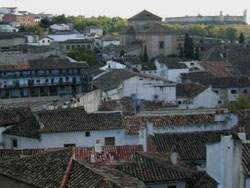 This is definitely the kind of small, country town that would make Don Quijote de la Mancha feel right at home. While in Chinchon you’ll also visit the remaining walls of the Castillo de los Condes. Then continue to the Theater of Lope de Vega a celebrated writer of the 16th century. End your tour visiting the Parador de San Agustin, a former center for studies in Theology, Latin and Grammar during the 15th century, and the Church of Our Lady of Asuncion, featuring a great painting by Goya. After a wonderful lunch, you’ll return to Madrid.
This is definitely the kind of small, country town that would make Don Quijote de la Mancha feel right at home. While in Chinchon you’ll also visit the remaining walls of the Castillo de los Condes. Then continue to the Theater of Lope de Vega a celebrated writer of the 16th century. End your tour visiting the Parador de San Agustin, a former center for studies in Theology, Latin and Grammar during the 15th century, and the Church of Our Lady of Asuncion, featuring a great painting by Goya. After a wonderful lunch, you’ll return to Madrid.

